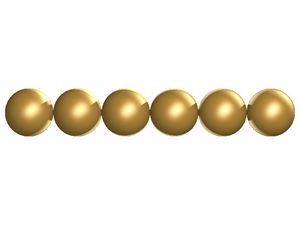Tangent linear hard sphere chains: Difference between revisions
Jump to navigation
Jump to search
Carl McBride (talk | contribs) No edit summary |
Carl McBride (talk | contribs) (Added a recent publication) |
||
| (2 intermediate revisions by the same user not shown) | |||
| Line 1: | Line 1: | ||
[[Image:LTHS.png|Example of the tangent linear hard sphere chain model, with m=6.|thumb|right]] | [[Image:LTHS.png|Example of the tangent linear hard sphere chain model, with m=6.|thumb|right]] | ||
The '''tangent linear hard sphere chain''' model consists of, as the name suggests, chains of varying monomer length (<math>m</math>), placed tangentially | |||
in a linear configuration. Each monomer is a [[hard sphere model]] and each | in a linear configuration. Each monomer is a [[hard sphere model]] and each molecule is rigid. | ||
For <math>m=5</math> [[smectic-A phase]] | ==Liquid crystals== | ||
For <math>m=5</math> [[Smectic phases |smectic-A phase]] becomes stable. For <math>m=6</math> the [[nematic phase]] becomes stable <ref>[http://dx.doi.org/10.1063/1.1389095 Carlos Vega, Carl McBride, and Luis G. MacDowell "Liquid crystal phase formation for the linear tangent hard sphere model from Monte Carlo simulations", Journal of Chemical Physics '''115''' pp. 4203-4211 (2001)]</ref>. | |||
==Excluded volume== | |||
The [[excluded volume]] for this model is given by (<ref>[http://dx.doi.org/10.1080/00268979500102391 Dave C. Williamson and George Jackson "Excluded volume for a pair of linear chains of tangent hard spheres with an arbitrary relative orientation", Molecular Physics '''86''' pp. 819-836 (1995)]</ref> Eq. 30): | |||
:<math>v_{\mathrm {excluded}}(\gamma)= (11m -3)v_s + (m-1)^2 v_c(\gamma)</math> | |||
where <math>\gamma</math> is the relative orientation of the principal axes of the molecules. See Ref. 2 for details | |||
of <math>v_s</math> and <math>v_c(\gamma)</math>. | |||
==References== | ==References== | ||
<references/> | |||
;Related reading | |||
*[http://dx.doi.org/10.1080/00268976.2013.812257 Thijs van Westen, Bernardo Oyarzún, Thijs J.H. Vlugt and Joachim Gross "An equation of state for the isotropic phase of linear, partially flexible and fully flexible tangent hard-sphere chain fluids", Molecular Physics '''112''' pp. 919-928 (2014)] | |||
[[category:models]] | [[category:models]] | ||
Latest revision as of 15:56, 5 May 2014

The tangent linear hard sphere chain model consists of, as the name suggests, chains of varying monomer length (), placed tangentially in a linear configuration. Each monomer is a hard sphere model and each molecule is rigid.
Liquid crystals[edit]
For smectic-A phase becomes stable. For the nematic phase becomes stable [1].
Excluded volume[edit]
The excluded volume for this model is given by ([2] Eq. 30):
where is the relative orientation of the principal axes of the molecules. See Ref. 2 for details of and .
References[edit]
- ↑ Carlos Vega, Carl McBride, and Luis G. MacDowell "Liquid crystal phase formation for the linear tangent hard sphere model from Monte Carlo simulations", Journal of Chemical Physics 115 pp. 4203-4211 (2001)
- ↑ Dave C. Williamson and George Jackson "Excluded volume for a pair of linear chains of tangent hard spheres with an arbitrary relative orientation", Molecular Physics 86 pp. 819-836 (1995)
- Related reading






